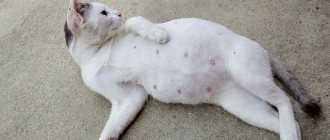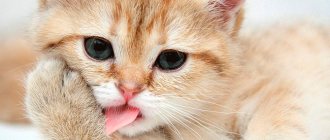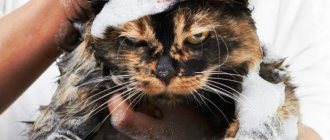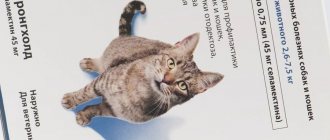What is better for fleas: drops or a collar?
Let’s immediately decide what is better for fleas: drops or a collar. Misconceptions in this matter drive many owners to despair. The fact is that the collar itself is an additional preventive measure. Putting a collar on a flea-infested kitten will not get rid of parasites!
The collar is used as a measure of additional protection, not even against fleas, but against ticks. After treatment with drops, the collar serves as a means of repelling new parasites. In addition, wearing a flea collar before the recommended age can lead to stunted growth and development.
Anti-tick sprays
They work on the same principle as drops. Some sprays can be used for pregnant females and babies under 2 months of age. It is necessary to avoid licking the drug until it dries completely. The effect of the drug lasts up to 4 weeks. Unfortunately, this group of drugs cannot be used for high-quality treatment in mono mode, since the drug is more difficult to dose and the effectiveness is very dependent on the correct application of the drug. When spraying the substance, a certain part may not reach the pet's body.
How do flea drops work?
Many owners are interested in how flea drops work. The mechanism of action of the drug depends on the active ingredients. Common flea drops eliminate parasites in several ways:
- Disturbance of nervous activity - the flea drinks blood, after which paralysis and death occurs.
- Contact action - the poison penetrates the body of the parasite through direct contact.
- Repellent effect - some flea drops do not kill, but only repel parasites with their smell.
Important! The duration of action depends on the type of active ingredients and their dosage. Most often, drops protect a cat from fleas for 8 weeks, and from ticks for 4 weeks.
How often should I treat my kitten for fleas?
How often do you treat a kitten for fleas as a preventive measure? According to generally accepted rules, preventive treatment against parasites is carried out quarterly. The period is considered optimal to interrupt the reproduction cycle of most parasites.
If a cat is infested with fleas, treatment is carried out outside the schedule. If infection is repeated, it is recommended to change the drops, since their protective effect should protect the kitten from 4 to 8 weeks (depending on the drug). Shampoos and some flea sprays do not have a prolonged action, that is, they kill fleas “here and now,” but the very next day the kitten can “pick up” fleas again.
Pay attention! If infected with subcutaneous mites, as prescribed by a veterinarian, treatment may be carried out more often.
When can you wash your kitten after applying the drops?
When can I wash my kitten after flea treatment? Typically, this information is indicated in the instructions for the drops. The absorption time of the drops depends on the base of the drug. oil drops cannot be washed off for 4–5 days; water-based preparations are absorbed faster, in 1–2 days.
The kitten should be bathed immediately if it has a local reaction to the use of drops. Symptoms of an allergic reaction include: redness, itching, swelling, and the appearance of fresh scratches. In rare cases and in case of overdose, the kitten may experience a reaction from the nervous system: drooling, convulsions, apathy.
What harm can fleas cause to a cat?
Fleas and ticks are blood-sucking insects that survive in the harshest conditions. They can live without food for one and a half months. Once on the body of a pet, they dig into the skin and begin to fill their stomach. In this case, the cat can lose quite a lot of blood. Ticks and fleas cause harm to a cat's health, which is expressed in the following:
- The bite sites are very itchy, the cat is constantly itching, causing wounds to itself. These wounds can easily become infected;
- Some time after infection, the cat begins to actively lose hair. This whole process can result in severe baldness;
- At the moment of a bite, toxic substances enter the cat’s bloodstream with the insect’s saliva, which can provoke a severe allergic reaction;
- Ticks and fleas become carriers of helminth eggs;
- Infection with parasites negatively affects the condition of the eyes, ears and nasopharynx. Chronic diseases, such as otitis media, often appear.
Fleas and ticks pose a particular danger to a kitten. Their exposure leads to anemia and rapid exhaustion. If help is not provided in a timely manner, the kitten may die.
By the way, you can learn all the intricacies of fighting fleas in kittens in the corresponding article: How to remove fleas from a kitten.
It is necessary to apply flea drops immediately after you notice signs of infestation. The sooner you start treatment, the greater the chance of successful treatment. Remember that it is not enough to treat the animal; you will also have to disinfect the room in which it lives.
Instructions: how to apply flea drops
Each package of drops contains instructions on how to give the kitten the drops. The instructions indicate indications and contraindications that must be studied first. Typically, the contraindications section indicates the minimum permissible age for processing.
The generally accepted rules for treating animals against fleas using drops include:
- The product is applied to intact, dry skin.
- Drops are applied to the back of the head or shoulder blades, so that the kitten does not reach the treated areas while washing.
- During the first hours after treatment, the kitten must be closely monitored as side effects may occur.
- If you are unable to ensure that the kitten does not lick the drops, you need to put an Elizabethan collar on it.
When treating kittens, it is not recommended to use products whose dosage is designed for large weights, for example 1 ml per 10 kg of body weight.
In addition, it is strictly not recommended to use drugs intended for dogs when treating cats.
How to rid a kitten of fleas without using medications
If the kitten cannot be treated with traditional flea drops, parasites can be removed using folk remedies. Using safe methods takes time and diligence. Ultimately, the parasites are removed manually by combing out.
Important! If a kitten has a severe flea infestation, it is better to consult a veterinarian who will assess the risks and potential medicinal effect of certain medications.
Common folk remedies for removing fleas are:
- A decoction of wormwood, tansy and eucalyptus.
- Natural apple cider vinegar.
- Infusion or decoction of fresh pine needles.
- Citrus infusion.
All of the above products have an unpleasant odor, which irritates and repels parasites. It is important to understand that the smell of apple cider vinegar and citrus fruits will be extremely unpleasant to the kitten. An animal may have an allergic reaction to a decoction of herbs.
At 1 month
At 1 month of age, kittens cannot be treated for fleas with traditional products. Absolutely all drops are toxic and can adversely affect the baby’s nervous system. At such a young age, a kitten can only be rid of fleas by hand.
To comb out parasites, you need a fine-tooth comb and your patience. To prevent fleas from biting and jumping off the kitten onto the floor, it is better to comb the fur with water and lemon juice. After the procedures, it is not recommended to bathe the kitten!
At 2 months
At 2 months (8 weeks), a kitten can be rid of fleas using drops. Almost all products can be used from 8 weeks. However, some drops are strongly recommended to be used only under medical supervision.
At the age of two months, the kitten can be bathed using anti-flea shampoos. Naturally, when using shampoos, you must follow safety precautions and thoroughly rinse the product from your pet’s fur. Until the kitten is dry after bathing, it must be protected from drafts and ensure that it does not lick itself.
Side effects
All prophylactic drugs intended to combat parasites are toxic. Drops released for treating kittens are usually classified as moderately toxic substances. It is important to understand that the conditional safety of the drops implies exclusively external use and the absence of an individual allergic reaction.
If you are treating a kitten with an unknown medical history, you should use the safest possible drops and consult your veterinarian first. In most cases, kittens picked up on the street or bought at a poultry market are infected not only with fleas, but also with worms. In case of mixed invasion, it is much more reasonable to use complex drugs (for external and internal parasites) in the form of drops.
Kitten itches after flea drops
In rare cases, if there is an individual intolerance to the active ingredients of the drops, the animal may experience an allergic reaction. If the kitten itches after flea drops, it is necessary to inspect the treatment area. Alarming symptoms are: redness, swelling and local fever. If you notice symptoms of an allergic reaction, the remaining droplets must be washed off from the kitten’s fur and skin.
In the absence of an allergic reaction, after treatment with drops, the kitten may itch during the day. The fact is that most drops quickly paralyze fleas, but the death of parasites can occur within several hours. An allergic reaction to already inflicted flea bites can last up to 12–20 hours. In addition, gentle drugs can only affect adults. In this case, the treatment is repeated after 4–10 days (according to the instructions or prescription of the veterinarian).
Review of popular flea drops - application, indications and contraindications
Never believe what it says on the label! That’s right, if the drops say “for kittens,” most likely we are talking about animals older than 2–3 months. For reference, animals under 9–12 months of age are also considered kittens, so manufacturers do not lie when they place colorful labels on packages.
Important! There are no absolutely safe flea drops. Always read the instructions before use! If you have any doubts about the safety of the drug, it is better to consult a veterinarian.
Leopard
The drug differs from most drops in the number of components. The main active ingredients of Bars drops are:
- Fipronil.
- Diflubenzuron.
- Dicarboximide.
Interacting, the active substances give a relatively good result, against the background of low toxicity. Once in the body of parasites, the active substances disrupt the functioning of their nervous system, which quickly leads to paralysis, and within 2-4 hours to death. In addition, Bars drops have a detrimental effect not only on adult parasites, but also on their eggs. Simply put, drop treatment interrupts the flea reproduction cycle, and this is very important at any stage of the infestation.
Indications for use: elimination of skin parasites, including fleas, lice, lice, subcutaneous and pasture ticks in animals older than 2 months.
Contraindications to the use of Bars drops:
- Individual intolerance.
- Acute allergic reactions.
- Immunocompromised animals: dehydrated, malnourished, sick or recovering from illness.
- Carriers of a viral infection.
- Kittens under 8 weeks and cats over 12 years old.
- When treating ear mites, the use of drops in case of perforation of the eardrum is not recommended.
According to the manufacturer, the active ingredients are distributed throughout the deep layers of the skin without penetrating into the systemic bloodstream. When used externally, the drug is considered moderately toxic, but drops must be used observing all safety precautions. Upon contact with mucous membranes, the active ingredients of Bars drops cause irritation; if swallowed, the toxicity of the drug increases sharply.
The recommended dosage is as follows:
- Cats weighing up to 1 kg – 0.3 ml.
- Cats weighing 1–3 kg – 0.6 ml.
- Cats weighing more than 3 kg – 1 ml.
Important! Drops are applied only to dry, intact skin.
Celandine
According to the manufacturer, Celandine drops can be used to prevent and treat infestations of skin parasites in kittens and adult cats. The residual effect of the drug lasts up to 2 months against fleas and up to 1 month against pasture ticks.
The active ingredients of Celandine drops are:
- Fipronil.
- Permethrin.
The range of the drug is aimed at combating external parasites: fleas, lice, lice and ticks. In addition, Celandine is prescribed for the treatment of subcutaneous mites. According to the manufacturer, the composition of the drops helps to effectively fight parasites at different stages of growth (from egg to mature individual). The active ingredients of the drops disrupt nerve conduction in parasites, which leads to their paralysis and death.
Contraindications to the use of Celandine drops:
- Kittens under 8 weeks old.
- Cats over 12 years old.
- Animals suffering from liver and kidney pathologies.
- Virus carriers.
- Weakened, emaciated, dehydrated animals.
- Animals that are sick or recovering from illness.
Note! When used externally in recommended doses, the drug is classified as moderately dangerous. Upon contact with mucous membranes, the active substances cause severe irritation. When licked and swallowed, drops can lead to both local reactions (salivation, allergies) and poisoning.
The dosage of Celandine drops is calculated by the weight of the animal:
- For cats weighing up to 2 kg – 0.5 ml.
- For cats weighing over 2 kg – 1 ml.
Types of drops
Veterinary pharmacies offer medications separately for dogs and cats. Some manufacturers produce products for all animals. When choosing, it is better to consult a specialist. But if this is not possible, use for each type of animal those drops that are intended for it.
The wrong solution is to use, for example, drops for cats to treat small dogs. The content of the active ingredient in products for cats and dogs may be the same, but they also contain other substances. The effect and side effects indicated by the manufacturer are valid for the type of animal for which the medicine is intended. In other cases, the reaction is unknown and therefore dangerous for the pet.
Products for cats
- Beafar. Drops based on natural margosa extract are safe not only for adult animals, but also for old, sick and small ones.
- Hartz. Apply to the spine and rub into the skin, after a day all adult fleas die.
- Frontline. Drops in 0.5 ml ampoules are suitable for cats. They are effective against worms, fleas, and ear mites.
- Rolf Club 3D. The drops instantly kill parasites and protect against fleas for a month. Not suitable for puppies up to three months old, nursing or pregnant.
Products for dogs
To protect adults and healthy animals, the following types of drops are used:
- Hartz Ultra Guard. They are used for minor and serious infections, and are especially effective for dogs that often walk outside or dogs that live in a kennel. Valid for four months. Not suitable for weakened and sick animals, puppies, pregnant dogs.
Hartz Ultra Guard drops protect your dog from fleas for three months - Stronghold. Drops based on selamectin, a substance that destroys parasites at all stages of development. Apply precisely along the upper part of the spine.
Stronghold drops kill fleas, larvae and parasite eggs - Frontline Combo. They squint at the withers and protect pets from fleas for a month.
After treating your dog with Frontlany drops, you won’t have to worry about flea infestation for a month. - Bars Forte. Domestic drops based on praziquantel (for helminths) and ivermectin (for fleas and ticks).
Bars drops are produced by a Russian company - Advantix. They repel and kill any blood-sucking parasites, thanks to the effective composition with the active ingredients imidacloprid and permethrin.
Advantix drops are available for dogs weighing up to 25 kg or more.
Table: characteristics of different types of drops for adult dogs and cats
| Name | Kind of animal | Active components | Validity period, months |
| Advantage | Cat | Imidacloprit | 1 |
| Advantix | Dog |
| 4–6 weeks |
| Advocate |
| 1 | |
| Bars Spot-On | Cat and dog |
| 1,5–2 |
| Bars-Forte | Fipronil | 1 | |
| Biafar | Permethrin | 5 weeks | |
| BlochNet |
| 1 | |
| Vectra 3D |
| ||
| Gamma |
| ||
| Dana | Diazinon | ||
| Pract-tic | Piriprol | ||
| Rolf club | Cat and dog |
| |
| Stronghold | Selamectin | ||
| Hartz Ultra Guard | Dog |
| |
| Frontline | Cat dog | Fipronil |
What products are suitable for kittens and puppies?
For dogs that are not yet 2-3 months old, the use of drops is contraindicated. If your pets have already reached this age, use the following medications to protect against fleas:
- Celandine Junior - drops based on permethrin and fipronil with minimal toxicity are suitable for puppies from 2 months: even the mother who licks them will not be poisoned;
- Dana - used from 10 weeks;
- Advantage - drops with imidacloprid for puppies and dogs weighing up to 4 kg, protect against lice, fleas, lice.
Suitable for kittens:
- Bars Forte;
- Dana;
- Celandine Junior.
To protect puppies and kittens, it is better to choose more gentle medications, for example, anti-flea shampoos or wormwood decoction and other folk remedies. Although they will have to be used more often due to their short duration (1-2 days), the small pet will be safe and will not be poisoned by toxic substances.
For kittens and puppies, the safest form of anti-flea products is shampoos.
Photo gallery: insecticidal drops for puppies and kittens
Celandine Junior drops contain fipronil and permethrin in concentrations that are safe for puppies and kittens
Bars Forte - insectoacaricidal drops that can be used to protect kittens from 10 weeks of age
The active component of Advantage drops is imidacloprid.
Dana drops are used to protect puppies from 2.5 months of age and dogs weighing up to 5 kg
Is it possible to treat pregnant and lactating animals with flea drops?
To protect such dogs and cats from parasites, the same medications are suitable as for kittens and puppies. Also, some adult medications are allowed for pregnant women, but after consulting a veterinarian.











